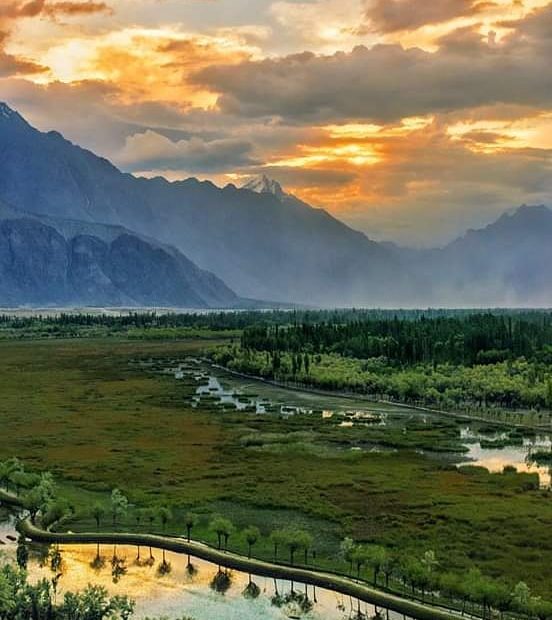During the Gilgit-Baltistan Assembly session on Tuesday, the Leader of the Opposition Amjad Hussain Advocate while presenting a resolution in the House said that the Khalsa Sarkar and Nautore Rule 1978 are invalid in all districts of Gilgit-Baltistan. He said that these colonial land rules are against Islam and the law.
But what is Khalsa Sarkar? Let’s look at its history.
What is Khailsa Sarkar?
In the 18th century, Maharaja Ranjit Singh established the Sikh empire in Lahore which was called Khalisa Sarkar (Sikh Government). The Khalisa empire extended to Jammu and Kashmir in the 19th century and then to Ladakh and Gilgit Baltistan through conquest by Governor Gulab Singh. During that time the occupied land was called Khalisa Sarkar land.
In 1846 after the Anglo-Sikh war, the British government sold Jammu and Kashmir for a sum of 7.5 million Nanakshahee Rupees to Gulab Singh under the terms of the Treaty of Amritsar. Gulab Singh became the first Maharaja of Jammu and Kashmir.
The Dogras initially didn’t give land ownership to the cultivators. Later, all the cultivable and barren lands were recorded through a land settlement in order to collect agricultural tax Maliya. Dogras gave ownership to the hereditary lands cultivated by the people for generations. But the common pastures of the mountains, deserts, and barren lands were considered Khalisa Sarkar land.
Land Settlement in Gilgit Baltistan during Dogra Rule
The first land settlement (Bandubasti) started in Baltistan in 1887. The cultivators were given land ownership while the local Rajas still hold most of the land as a Jagir (feudal land). The Jagirs were divided into Mustaqil Kashtkar and Ghair e Mustaqil Kashtkar. The remaining barren lands, pastures, and mountains were owned by the Dogra regime and declared Khalisa Sarkar land.
The second land settlement in the Gilgit agency started from 1906 to 1917. The land settlement didn’t take place in Punial, Koh-i-Ghizer (Gupis), Ishkoman, and Yasin. Punial, Koh-i-Ghizer, and Ishkoman districts were jagirs of the local Rajas. Similarly, Darel, Tangir, and Chilas were also unsettled. Hunza and Nagar were Jagirs of Mirs. Unlike Baltistan and Gilgit agency, the Mirs and Rajas owned the lands of these areas as their Jagir without any land settlement.
Nautore rules
In 1936, the Dogra regime introduced the Nautore rule. In 1942 The Gilgit subdivision Rule was introduced. After the independence, the Baltistan Nautore Rules were introduced in 1965-66 in Baltistan agency.
In 1978-80 The Northern Areas Nautore Rules were introduced and extended to the whole of Gilgit Baltistan including Diamer, Gilgit, Hunza, Nagar, Ghizer, and Baltistan. Khalisa land allotment rules were formed under this rule.
The Government of Pakistan discontinued the allotments of lands under Nautore rules in 1986. Currently, Khalisa land allotment under the Nautore rule is banned in Gilgit Baltistan. But it is pertinent to mention that the Government of Gilgit-Baltistan withdrew from its claim of Nautore withdrawal, in a case adjudicated in a competent court of law, over Harpan Dass in Chilas.
Khalisa Sarkar Land Reform
It is pity to say that the last land reform that took place in GB was in the year 1940. The Baltistan Nautore rule and Northern Areas Nautore rule is the extension of Dogra’s 1940s Gilgit subdivision Nautore rule.
In 2016, The PMLN government formed a committee to bring land reforms in GB. The current PTI govt has also formed a committee for this purpose. But no progress has been made so far.
Current Situation
Currently, there are three types of land in Gilgit Baltistan Bandubasti Zameen, Jageer and Khalisa Sarkaar. Citizens have ownership of Bandubsasti Zameen only. While Rajas have still sizeable Jageers(feudal land) in the Baltistan division; the citizens cultivate the land but don’t own the ownership. Similarly, a lot of cases are pending in courts for the ownership of Pastures between villagers and the state over Khalisa land. Moreover, the barren Khalisa lands are being occupied by land mafias and influential people. Similarly, the sale of Khalisa land is being done without the transfer of any land record. That’s why a lot of dispute arises among the people. Furthermore, disputes often arise between the people and the government over the Khalisa land.
Way Forward
With the construction of CPEC and the development of tourism, it is the need of the hour to repeal the colonial Khalisa Sarkar rule and introduce the Gilgit Baltistan Land Reform in the GB assembly in order to give ownership to the indigenous populace of GB. In spite of setting a committee, the reforms must be brought through GB Assembly by taking all stakeholders in confidence. While introducing land reforms it needs to be kept in mind that most of the Khalisa land is either occupied by land mafias or influential people of the village. A survey needs to be done in order to assess how much Khalisa lands were occupied by land mafias. Moreover, the Government needs to formulate a strategy to recover the occupied Khalisa land and redistribute it equally among the residents and villagers.
You may also read History of Gilgit Baltistan in Brief
Skardu.pk is one of the leading authentic news and information platform focusing on adventure tourism, regional and world affairs.

